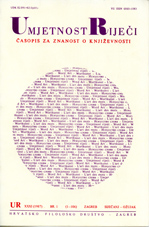Kolaž - transsemiotički citatni žanr
Collage as a trans-semiotic quotation genre
Author(s): Dubravka Oraić TolićSubject(s): Literary Texts
Published by: Hrvatsko filološko društvo
Summary/Abstract: The article is based on the assumption that collage is a quotation genre, that it was created and developed as a part of avant-garde art in the first two decades of the present century and that its first form was aleatory. Art quotation can be separated into three main groupings: 1. intra-semiotic (relationships are created within individual arts), 2. inter-semiotic (relationships created between arts) and 3. trans-semiotic (relations are set up between art and non-art in the widest sense). Collage falls into the third category and is defined as a trans-semiotic quotation genre. In the visual arts the materials used are the actual materials provided by civilization or by nature (scraps of newspaper, fabric, wires. wood etc.). literary collage uses their verbal equivalents (newspaper quotations, advertisements, chronicles, cliches, fixed phrases etc.). Aleatory collage of the first two decades of the century is analyze d on the basis of Dadaism (Hannah Hoch) and Dadaist poetry (Tristan Tzara, Hans Arp, Walter Mehring). Its historical and unrepeatable model is built upon the categoric semiotic quadrangle: semantics, syntax, pragmatics and global cultural function. Two basic types of aleatory collage are distinguished: AC I (Picasso, Tzara, Arp) and AC II (Hannah Hoch, Walter Mehring). The dominant features of AC I are large-scale quotational polemics with the institutions of European art: the dominant features of AC II are large-scale quotational dialogue with own civilization, the material world and the whole area of non-art. AC I is founded on the principles of the first aleatory montage; in AC II the aleatory element is controlled by deeper semantic and pragmatic dimensions. AC I is pure aesthetic provocation calculated to shock; what is provocative in AC II is designed to be decoded. The basic function of AC I is to toppie the primary principles of European art (mimesis, autonomy, the organic rounded text, individual creativity); the basic function of AC II is the creation of a new kind of art, an art closer to contemporary technological civilization.
Journal: Umjetnost riječi
- Issue Year: 1987
- Issue No: 1
- Page Range: 7-22
- Page Count: 16
- Language: Croatian
- Content File-PDF

